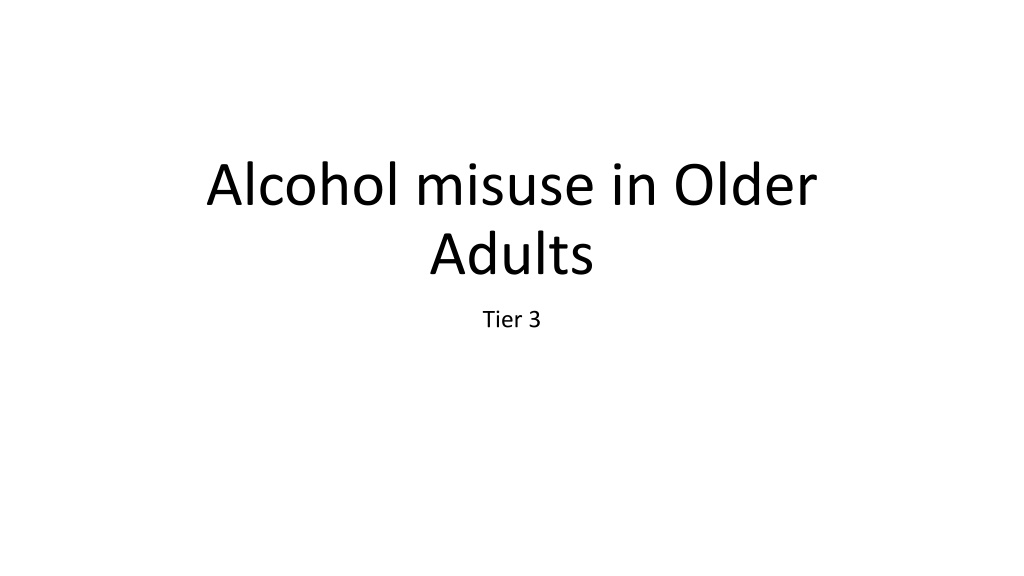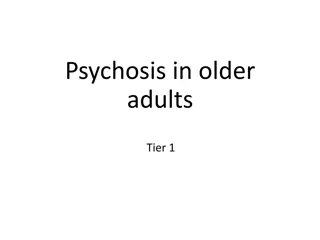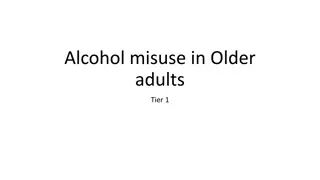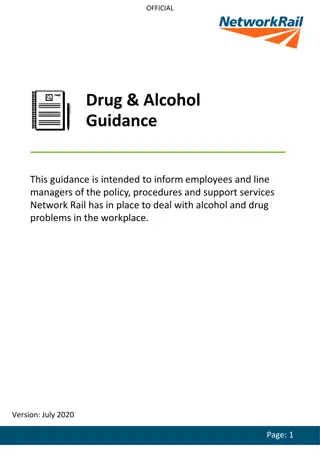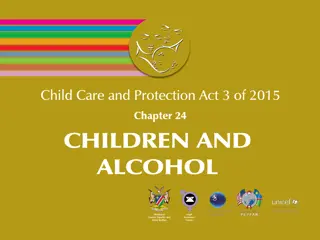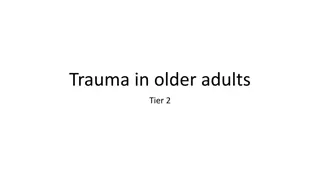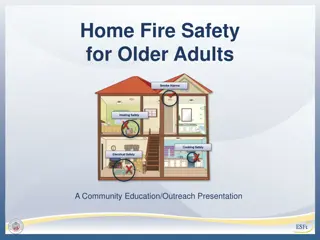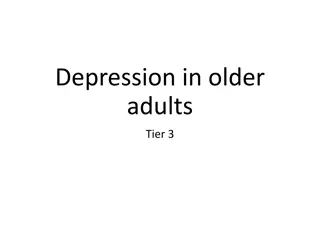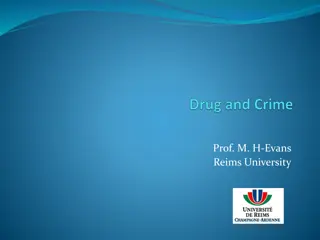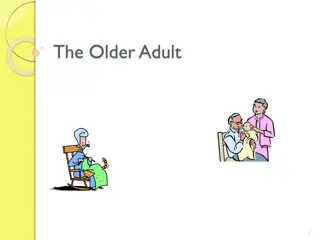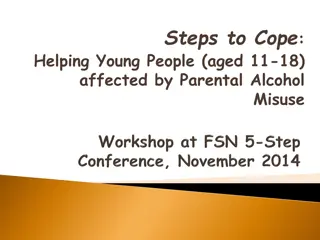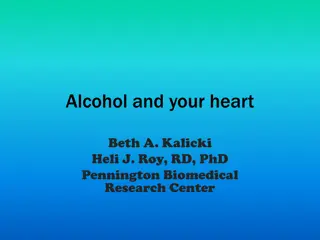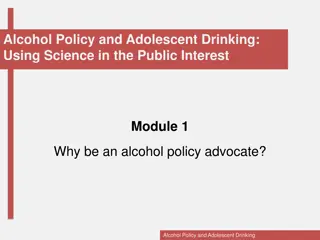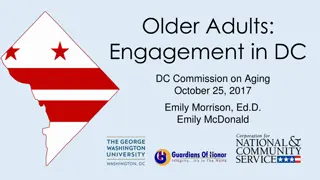Alcohol misuse in Older Adults
Alcohol misuse in older adults can lead to harmful health consequences due to increased sensitivity to alcohol with age. Barriers to identification and treatment, such as ageism and underreporting, can hinder intervention efforts. Understanding the impact of alcohol on physical health is crucial for addressing the unique challenges faced by older adults in managing alcohol consumption.
Download Presentation

Please find below an Image/Link to download the presentation.
The content on the website is provided AS IS for your information and personal use only. It may not be sold, licensed, or shared on other websites without obtaining consent from the author.If you encounter any issues during the download, it is possible that the publisher has removed the file from their server.
You are allowed to download the files provided on this website for personal or commercial use, subject to the condition that they are used lawfully. All files are the property of their respective owners.
The content on the website is provided AS IS for your information and personal use only. It may not be sold, licensed, or shared on other websites without obtaining consent from the author.
E N D
Presentation Transcript
Alcohol misuse in Older Adults Tier 3
What is normal? Weekly limits can be misleading. If just a quarter of the recommended weekly amount is drunk over a matter of hours, this is more likely to be harmful.
Harmful drinking and alcohol dependence Harmful drinking is defined as a pattern of alcohol consumption causing health problems directly related to alcohol. Alcohol dependence is characterised by craving, tolerance, a preoccupation with alcohol, and continued drinking in spite of harmful consequences Older adults tend to drink less alcohol than younger adults However, 1 in 5 older men and 1 in 10 older women drink enough to harm themselves. Often the diagnosis is missed These figures have increased by 40 percent in men and 100 percent in women over the past 20 years
Effects of ageing Older adults have a higher blood alcohol concentration for a given amount of alcohol consumed due to: Higher body fat to water ratio Reduction in total body volume Older adults become more sensitive to the effects of alcohol Even if older adults drink the same amount of alcohol as when they were younger it is likely to affect them adversely
Barriers to identification and treatment of harmful drinking AGEISM UNDER REPORTING MIS-ATTRIBUTION It s all he/she has in life Viewed as stigmatising Misidentifying as physical illness/depression /cognitive impairment Poorer detection of drinking in: Women Higher levels of education Higher social class Widows STEREOTYPING
Impact of alcohol on older adults Health problems can make an older adults more susceptible to the side effects of alcohol Alcohol can damage nearly every part of the body Alcohol can also : add to the effect of some medications, e.g. painkillers or sleeping tablets. reduce the effect of others, e.g. medication to thin the blood (warfarin) this can increase the risk of bleeding or developing a clot or blockage in your bloodstream.
Alcohol can impact on their Physical health The stomach lining ulcers or bleeding The liver cirrhosis and liver failure Heart muscle heart failure produces a build-up of fluid in the lungs which makes you breathless Causes cancer of the mouth, stomach and liver Malnutrition alcohol has lots of calories for energy, but none of the protein, fats or vitamins you need to keep your body in good repair Sense of balance falls and accidents (even with 'sensible' drinking) Causes blackouts or fits Causes stroke Poor sleep causing daytime drowsiness Causes subdural haematomas following a minor fall.
Alcohol can impact on their Mental health Anxiety Depression Auditory hallucinations : This is less common but can happen if you have been drinking heavily for a long time. It starts with vague noises, like leaves rustling, and gradually becomes distinct voices. These can be unpleasant and are usually distracting. Visual hallucinations : Alcohol withdrawals can cause people to see things which are not there Confusion/ Delirium: this is related to the lack of thiamine, an important vitamin. Permanent deficiency causes a disease called Korsakoff s which affects memory and functioning. Dementia: You can lose your ability to remember new information, which may be put down to 'old age', instead of the effects from alcohol. Alcohol related brain injury and alcohol dementia Concurrent misuse of illegal drugs/ benzodiazepines
Presentations Older adults with alcohol problem can present with Sleep complaints Cognitive impairment, memory or concentration disturbance Liver-function abnormalities Incontinence Poor hygiene and self-neglect Unusual restlessness/agitation or persistent tiredness Unexplained nausea and vomiting Changes in eating habits Slurred speech, tremor, poor coordination Frequent falls and unexplained bruising Malnutrition Masking by other mental and physical disorder
What are some of the triggers for older adults to drink too much ? Possible triggers: Bereavement Difficulty getting around and social isolation can lead to boredom and depression Physical illness including pain. Some people might use alcohol to make these difficulties more bearable Self-medication using alcohol to manage untreated mental illness About a third of older adults with drinking problems (mainly women) develop them for the first time in later life.
What signs might suggest the person is drinking too much? Finding lots of empty bottles of alcohol in the home If the person is drinking in the morning The person showing withdrawal symptoms when they have not had a drink Other people being concerned about the amount the person is drinking The person having symptoms both physical and mental due to the impact of excess alcohol
Assessment NICE guidelines describe four levels of assessment Level One is case identification/diagnosis Level Two is withdrawal assessment Level Three is triage assessment Level Four is comprehensive assessment The assessment of risk should be part of any assessment. This includes risk to self (including unplanned withdrawal, suicidality, and neglect) and risk to others. The extent of any associated health and social problems and the need for assisted alcohol withdrawal should also be part of assessment.
Level 1 - Case identification Case identification should consider: establishing the probable presence of an alcohol-use disorder; the level of alcohol consumption (as units of alcohol per day or per week); distinguish harmful drinking from alcohol dependence; establishing the presence of risks (for example, self-harm, harm to others, medical/mental health emergencies, and safeguarding children); establishing the capacity to consent to treatment or onward referral; experience and outcome of previous intervention(s); establishing the willingness to engage in further assessment and/or treatment; establishing the presence of possible co-existing common problems features (for example, additional substance misuse, medical, mental health, and social problems); and determining the urgency of referral and/or an assessment for alcohol withdrawal. Screening to include AUDIT tool
Your score ALCOHOL USE DISORDERS IDENTIFICATION TEST (AUDIT) Scoring system 0 1 2 3 4 NEVER (GO TO Q9&10) MONTHLY OR LESS 2 - 4 TIMES PER MONTH 2 - 3 TIMES PER WEEK 4+ TIMES PER WEEK 1. HOW OFTEN DO YOU HAVE A DRINK CONTAINING ALCOHOL? 2. HOW MANY UNITS OF ALCOHOL DO YOU DRINK ON A TYPICAL DAY WHEN YOU ARE DRINKING? 1 -2 3 - 4 5 - 6 7 - 8 10+ DAILY OR ALMOST DAILY 3. HOW OFTEN HAVE YOU HAD 6 OR MORE UNITS IF FEMALE, OR 8 OR MORE IF MALE, ON A SINGLE OCCASION IN THE LAST YEAR? LESS THAN MONTHLY NEVER MONTHLY WEEKLY IF TOTAL FOR QUESTIONS 2 + 3=0 THEN YOU CAN SKIP TO Q9 & 10 DAILY OR ALMOST DAILY 4. HOW OFTEN DURING THE LAST YEAR HAVE YOU FOUND THAT YOU WERE NOT ABLE TO STOP DRINKING ONCE YOU HAD STARTED? LESS THAN MONTHLY NEVER MONTHLY WEEKLY DAILY OR ALMOST DAILY 5. HOW OFTEN DURING THE LAST YEAR HAVE YOU FAILED TO DO WHAT WAS NORMALLY EXPECTED FROM YOU BECAUSE OF YOUR DRINKING? LESS THAN MONTHLY NEVER MONTHLY WEEKLY 6. HOW OFTEN DURING THE LAST YEAR HAVE YOU NEEDED AN ALCOHOLIC DRINK IN THE MORNING TO GET YOURSELF GOING AFTER A HEAVY DRINKING SESSION? DAILY OR ALMOST DAILY LESS THAN MONTHLY NEVER MONTHLY WEEKLY DAILY OR ALMOST DAILY 7. HOW OFTEN DURING THE LAST YEAR HAVE YOU HAD A FEELING OF GUILT OR REMORSE AFTER DRINKING? LESS THAN MONTHLY NEVER MONTHLY WEEKLY 8. HOW OFTEN DURING THE LAST YEAR HAVE YOU BEEN UNABLE TO REMEMBER WHAT HAPPENED THE NIGHT BEFORE BECAUSE YOU HAD BEEN DRINKING? DAILY OR ALMOST DAILY LESS THAN MONTHLY NEVER MONTHLY WEEKLY YES, BUT NOT IN THE LAST YEAR YES, DURING THE LAST YEAR 9. HAVE YOU OR SOMEBODY ELSE BEEN INJURED AS A RESULT OF YOUR DRINKING? NO YES, BUT NOT IN THE LAST YEAR YES, DURING THE LAST YEAR 10. HAS A RELATIVE OR FRIEND, DOCTOR OR OTHER HEALTH WORKER BEEN CONCERNED ABOUT YOUR DRINKING OR SUGGESTED THAT YOU CUT DOWN? NO Total
Score Drinking category Intervention On AUDIT No specific intervention. Consider offering information and promote continued drinking within lower risk levels. If working towards abstinence encourage continued reduction. 0-7 Lower risk 8-15 Hazardous/ increasing risk Simple brief advice Provide information. Encourage to reduce. 16-19 Harmful/higher risk Extended brief intervention. Offer sessions to help reduce drinking and risk-taking behaviour Focus on enhancing motivation to change. Community - Complete SADQ (Severity of Alcohol Dependence Questionnaire) Possible dependence 20+ Inpatient Monitor using CIWA-Ar (withdrawal assessment scale) Consider seeking specialist advice and referral to alcohol service if person wants to stop drinking.
Level 2: Withdrawal assessment The assessment of the need for a medically managed withdrawal also uses the AUDIT score. A person who drinks more than 15 units of alcohol a day or scores 20 on AUDIT should be considered for an assisted withdrawal. Inpatient and residential assisted withdrawal should be considered if one or more of the following criteria are met: daily intake over 30 units of alcohol; have a score of more than 30 on the Severity of Alcohol Dependence Questionnaire (SADQ); have a history of epilepsy or experience of withdrawal-related seizures or delirium tremens during previous assisted withdrawal programmes; need concurrent withdrawal from alcohol and benzodiazepines; and regularly drink between 15 and 20 units of alcohol per day and have: significant psychiatric or physical comorbidities (for example, chronic severe depression, psychosis, malnutrition, congestive cardiac failure, unstable angina, chronic liver disease); or a significant learning disability or cognitive impairment.
Withdrawal assessment Timeline from last drink Symptoms Alcohol withdrawal symptoms Generalised hyperactivity, tremor, sweating, nausea, retching, mood fluctuation, tachycardia, increased respirations, hypertension, and mild pyrexia Onset: 6 8 hours Peak: 10 30 hours Subsides: 40 50 hours Withdrawal seizures Onset: 0 48 hours Auditory and visual hallucinations may develop that are characteristically frightening Onset: 12 hours Duration: 5 6 days Delirium tremens: coarse tremor, agitation, fever, tachycardia, profound confusion, delusions, and hallucinations Onset: 48 72 hours
Treatment Older adults who engage in treatment have better outcomes. It is therefore important to screen older adults for alcohol use. Most people receive support to stop drinking and recovery support in the community. Treatments include: Brief alcohol intervention Support groups Psychological or talking treatments Detoxification or detox . This may involve giving medication to reduce withdrawal symptoms and then tailing off and stopping it after a few days or weeks. Thiamine replacement (either oral or parenteral).
Who are the target groups for Screening & Brief Intervention? Hazardous drinkers, including regular excessive drinkers & binge drinkers Harmful drinkers, including regular excessive drinkers & binge drinkers NOT alcoholics (alcohol dependent)
What is brief alcohol intervention? Information, advice and encouragement to the patient to consider the positives and negatives of their drinking behaviour, plus support and help to the patient if they do decide they want to cut down on their drinking Improves motivation for change of drinking behaviour Opportunistic administered to patients who have not attended a consultation to specifically discuss their drinking (Alcohol Harm Reduction Strategy for England)
Key Points of brief alcohol intervention Patient should agree to the information being provided. Offering information and advice with permission is a key aspect of taking a motivational approach. Other skills to enhance motivation (OARS): - Open questions - Affirmations - Reflections - Summaries All conversations conducted in spirit of collaboration/partnership , accepting the person (being empathic, compassionate, emphasising that they have choice, and drawing out from them their views about their situation and ideas they may have for making changes).
ANYONE THAT GETS INTOXICATED MAY BE AT RISK OF ACCIDENTS OR INJURIES SOME MEDICATIONS AND ALCOHOL DON T MIX CHECK WITH YOUR DOCTOR YOU MAY BE AT RISK EVEN AFTER DRINKING ONLY 1 OR 2 UNITS E.G. WHEN DRIVING OR OPERATING MACHINERY The benefits of cutting down Planning to cut down some tips AVOID GOING TO PUB AFTER WORK WHEN BORED OR STRESSED HAVE A WORKOUT INSTEAD OF DRINKING PLAN THINGS TO DO AT THE TIMES YOU WOULD USUALLY DRINK WHEN YOU DO DRINK, SET YOURSELF A LIMIT AND STICK TO IT EAT SOMETHING BEFORE YOU START DRINKING START DRINKING LATER IN THE DAY QUENCH YOUR THIRST WITH NON-ALCOHOLIC DRINKS BEFORE AND BETWEEN ALCOHOLIC DRINKS AVOID DRINKING IN ROUNDS DRINK LOWER STRENGTH ALCOHOL HAVE SMALLER DRINKS TAKE SMALLER SIPS EXPLORE OTHER INTERESTS HAVE A FEW ALCOHOL FREE DAYS EACH WEEK KEEP A DRINK DIARY LET YOUR FRIENDS AND FAMILY KNOW YOU ARE CUTTING DOWN AND ASK THEM TO SUPPORT YOU IMPROVED MOOD IMPROVED RELATIONSHIPS SAVE MONEY SLEEP BETTER MORE ENERGY LOSE WEIGHT NO HANGOVERS REDUCED RISK OF INJURY IMPROVE MEMORY BETTER PHYSICAL SHAPE REDUCED RISK OF 60 DIFFERENT MEDICAL CONDITIONS E.G. HIGH BLOOD PRESSURE, CANCER, LIVER DISEASE, BRAIN DAMAGE
Particular Challenges for older adults who drink excessively They are at higher risk of hospitalisations and institutionalisation Often they have repeated assessment of capacity this may be related to the risks of where they reside, other risks related to drinking including fire risks, vulnerability etc Older women with neurological or mental disorder who misuse drugs or alcohol are at the highest risk of experiencing elder abuse Provision of culturally appropriate services for older BAME groups is often a challenge
Resources Addaction Supports individuals and families with the ultimate aim of abstinence. Email: info@addaction.org.uk Alcoholics Anonymous National helpline: 0845 769 7555 MPC_05_03 Alcohol and Other Addictive Drugs | MPC_05_03 Alcohol and Other Addictive Drugs (mindedforfamilies.org.uk) This is an easy to access website for older adults and their families which has good advice about symptoms and strategies to reduce alcohol and substance misuse in older adults
